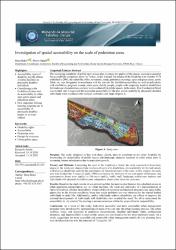| dc.contributor.author | Bekci, Banu | |
| dc.contributor.author | Sipahi, Merve | |
| dc.date.accessioned | 2023-08-18T06:46:47Z | |
| dc.date.available | 2023-08-18T06:46:47Z | |
| dc.date.issued | 2023 | en_US |
| dc.identifier.citation | Bekci, B. & Sipahi, M. (2023). Investigation of spatial accessibility on the scale of pedestrian areas. Journal of the Faculty of Engineering and Architecture of Gazi University, 38(4), 2155-2165. https://doi.org/10.17341/gazimmfd.812513 | en_US |
| dc.identifier.issn | 1300-1884 | |
| dc.identifier.issn | 1304-4915 | |
| dc.identifier.uri | https://doi.org/10.17341/gazimmfd.812513 | |
| dc.identifier.uri | https://hdl.handle.net/11436/8058 | |
| dc.description.abstract | Purpose: The study, designed in line with these criteria, aims to contribute to the cities' livability by determining the accessibility of public spaces and landscape character analyzes in cities where there is increasing intense urbanization due to population growth. Theory and Methods: Concerning the users of the Cumhuriyet Street, the study consisted of three basic stages (i) the landscape characteristic analysis of users with disabilities, (ii) availability for the individuals with physical disabilities and (iii) the examination of behavioral maps of the users. In this context, the study area was divided into 5 stages (Lynch, 1984) considering the intensity of use and spatial differences, and questionnaire forms were applied to 186 users (public, public staff, landscape architecture students and individuals with physical disabilities) and independent observation forms for each area. Results: Based on the study results, it was determined that the most needed features for a disabled person in urban pedestrian transportation are (A) urban facilities, (B) roads and sidewalks, (C) implementation of rights of disabled, (D) and the problems about inability to access to architectural structures and open public spaces due to the adverse conditions; these four major problems are even observed by the normal bodied individuals in daily life. Additionally, unlike individuals without disabilities, the efforts to improve the personal developments of individuals with disabilities also revealed the need "for all to understand the accessibility in city centres" by creating a serious awareness within the scope of social responsibility. Conclusion: As a result of this study, both more accessible and more sustainable urban management strategies were developed by incorporating all users of the city into the urban planning process. The urban facilities, roads, and sidewalks in pedestrian transportation, disabled individuals' rights, architectural structures, and inaccessibility in open public spaces are also found to be the most important needs. As a result, suggestions for more accessible and sustainable urban management models for city planning have been developed in line with the principle of "Design for All". | en_US |
| dc.language.iso | eng | en_US |
| dc.publisher | Gazi Üniversitesi | en_US |
| dc.rights | info:eu-repo/semantics/openAccess | en_US |
| dc.subject | Disability rights | en_US |
| dc.subject | Accessibility | en_US |
| dc.subject | Pedestrian zone | en_US |
| dc.subject | Urban public space | en_US |
| dc.subject | Design for everyone | en_US |
| dc.title | Investigation of spatial accessibility on the scale of pedestrian areas | en_US |
| dc.type | article | en_US |
| dc.contributor.department | RTEÜ, Mühendislik ve Mimarlık Fakültesi, Peyzaj Mimarlığı Bölümü | en_US |
| dc.contributor.institutionauthor | Bekci, Banu | |
| dc.contributor.institutionauthor | Sipahi, Merve | |
| dc.identifier.doi | 10.17341/gazimmfd.812513 | en_US |
| dc.identifier.volume | 38 | en_US |
| dc.identifier.issue | 4 | en_US |
| dc.identifier.startpage | 2155 | en_US |
| dc.identifier.endpage | 2165 | en_US |
| dc.relation.journal | Journal of the Faculty of Engineering and Architecture of Gazi University | en_US |
| dc.relation.publicationcategory | Makale - Uluslararası Hakemli Dergi - Kurum Öğretim Elemanı | en_US |


















